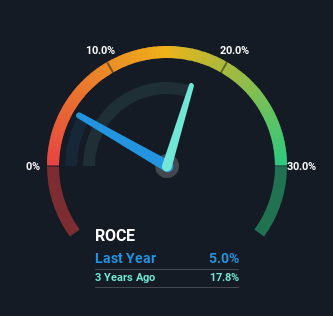If we want to find a stock that could multiply over the long term, what are the underlying trends we should look for? Firstly, we'll want to see a proven return on capital employed (ROCE) that is increasing, and secondly, an expanding base of capital employed. Put simply, these types of businesses are compounding machines, meaning they are continually reinvesting their earnings at ever-higher rates of return. In light of that, when we looked at Weng Fine Art (FRA:WFA) and its ROCE trend, we weren't exactly thrilled.
Return On Capital Employed (ROCE): What Is It?
If you haven't worked with ROCE before, it measures the 'return' (pre-tax profit) a company generates from capital employed in its business. To calculate this metric for Weng Fine Art, this is the formula:
Return on Capital Employed = Earnings Before Interest and Tax (EBIT) ÷ (Total Assets - Current Liabilities)
0.05 = €1.3m ÷ (€31m - €4.0m) (Based on the trailing twelve months to June 2023).
So, Weng Fine Art has an ROCE of 5.0%. Ultimately, that's a low return and it under-performs the Specialty Retail industry average of 8.4%.
Check out our latest analysis for Weng Fine Art

Historical performance is a great place to start when researching a stock so above you can see the gauge for Weng Fine Art's ROCE against it's prior returns. If you'd like to look at how Weng Fine Art has performed in the past in other metrics, you can view this free graph of Weng Fine Art's past earnings, revenue and cash flow.
What Does the ROCE Trend For Weng Fine Art Tell Us?
When we looked at the ROCE trend at Weng Fine Art, we didn't gain much confidence. To be more specific, ROCE has fallen from 9.4% over the last five years. And considering revenue has dropped while employing more capital, we'd be cautious. If this were to continue, you might be looking at a company that is trying to reinvest for growth but is actually losing market share since sales haven't increased.
On a side note, Weng Fine Art has done well to pay down its current liabilities to 13% of total assets. So we could link some of this to the decrease in ROCE. What's more, this can reduce some aspects of risk to the business because now the company's suppliers or short-term creditors are funding less of its operations. Some would claim this reduces the business' efficiency at generating ROCE since it is now funding more of the operations with its own money.
The Bottom Line
In summary, we're somewhat concerned by Weng Fine Art's diminishing returns on increasing amounts of capital. And, the stock has remained flat over the last five years, so investors don't seem too impressed either. Unless there is a shift to a more positive trajectory in these metrics, we would look elsewhere.
Weng Fine Art does come with some risks though, we found 6 warning signs in our investment analysis, and 2 of those are potentially serious...
For those who like to invest in solid companies, check out this free list of companies with solid balance sheets and high returns on equity.
Valuation is complex, but we're here to simplify it.
Discover if Weng Fine Art might be undervalued or overvalued with our detailed analysis, featuring fair value estimates, potential risks, dividends, insider trades, and its financial condition.
Access Free AnalysisHave feedback on this article? Concerned about the content? Get in touch with us directly. Alternatively, email editorial-team (at) simplywallst.com.
This article by Simply Wall St is general in nature. We provide commentary based on historical data and analyst forecasts only using an unbiased methodology and our articles are not intended to be financial advice. It does not constitute a recommendation to buy or sell any stock, and does not take account of your objectives, or your financial situation. We aim to bring you long-term focused analysis driven by fundamental data. Note that our analysis may not factor in the latest price-sensitive company announcements or qualitative material. Simply Wall St has no position in any stocks mentioned.
About DB:WFA
Weng Fine Art
Operates as an art dealer primarily in Europe and the United States.
Mediocre balance sheet with low risk.
Market Insights
Community Narratives



